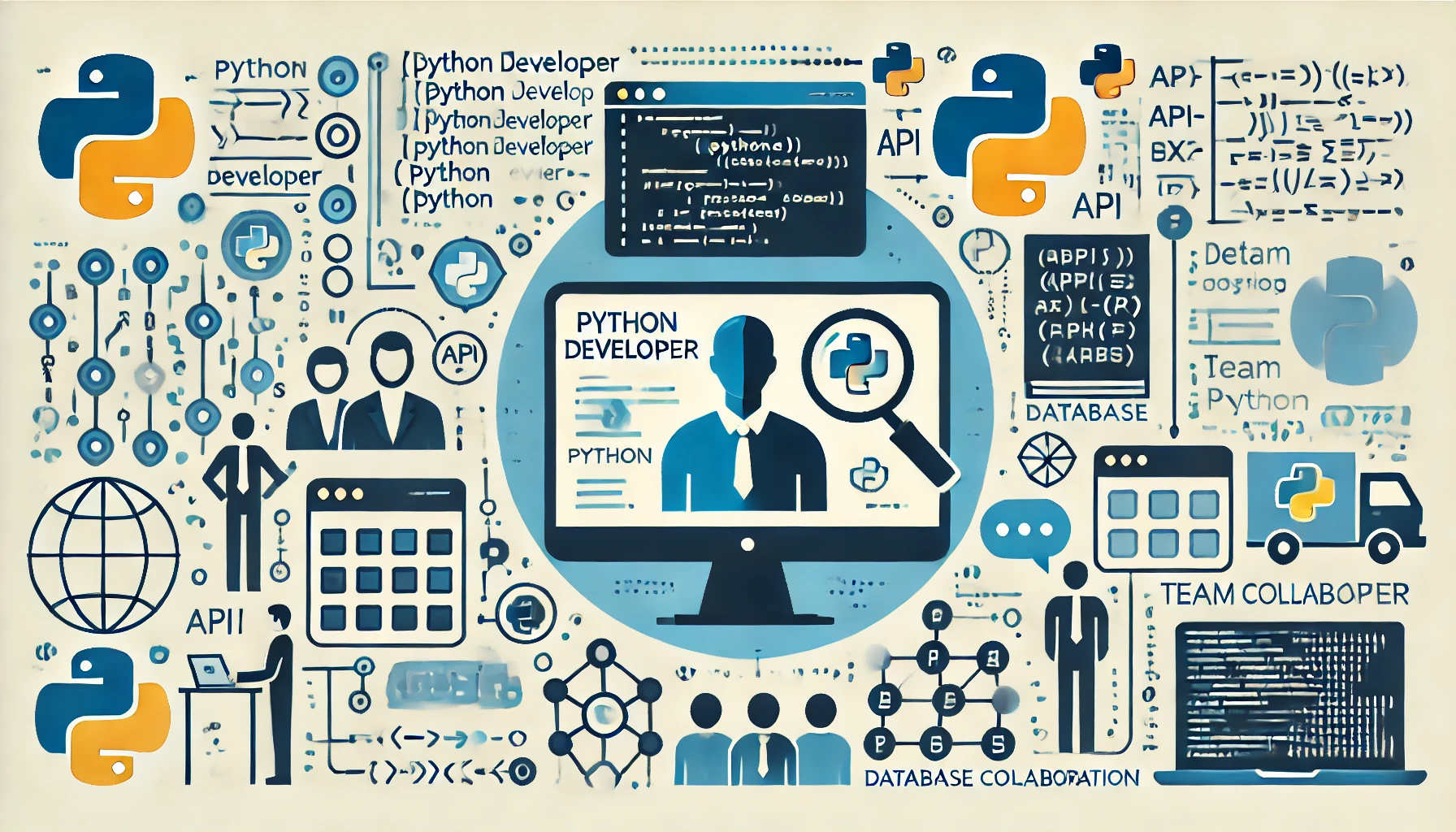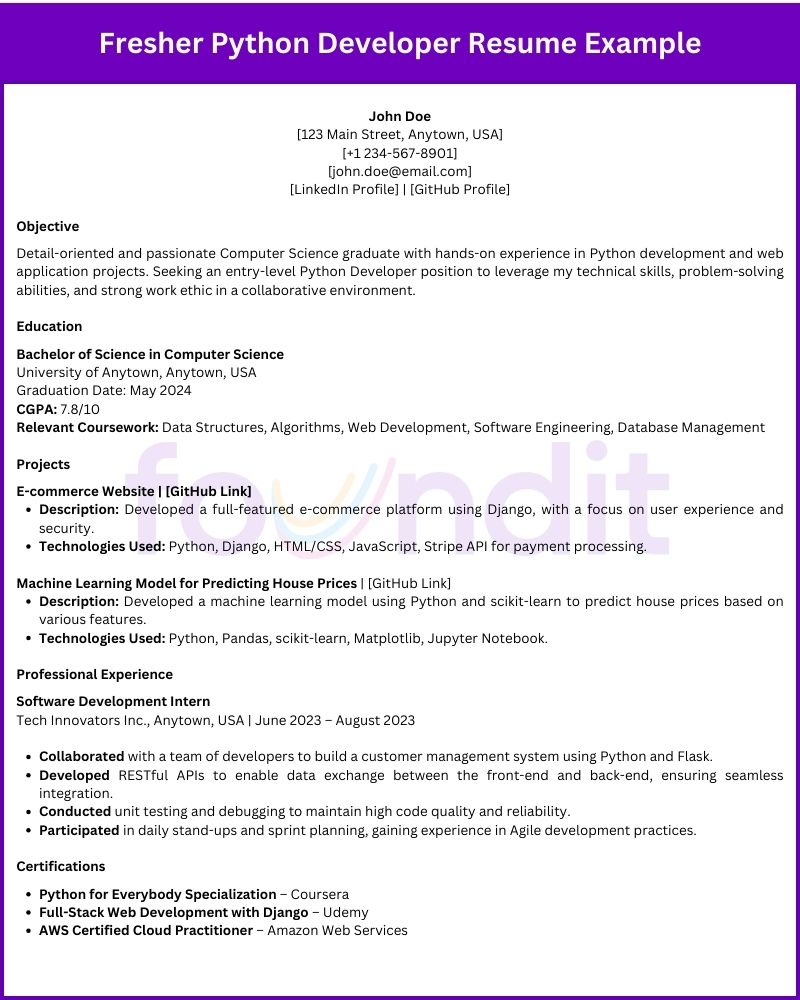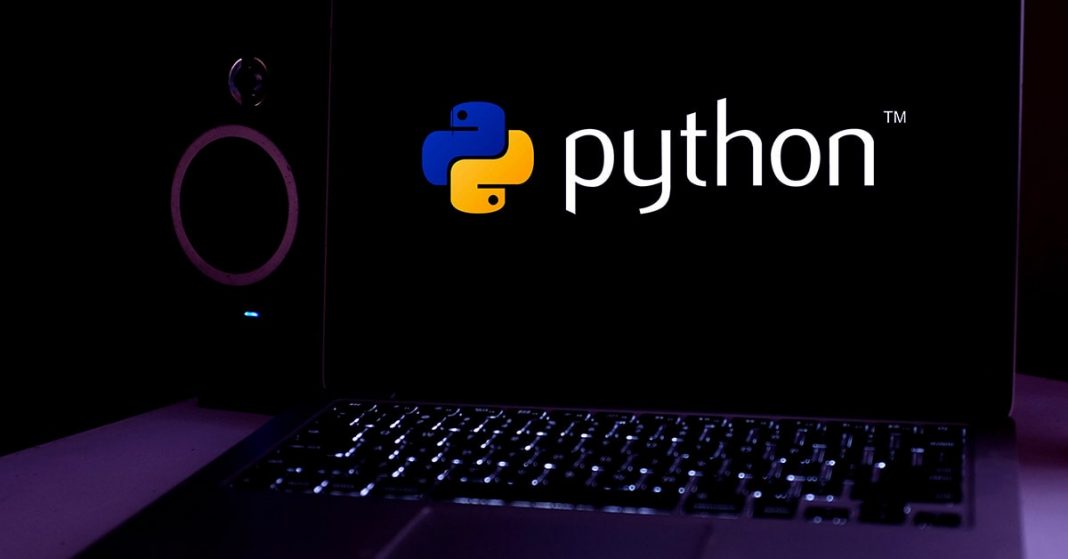What is Python ?
Python is a programming language that focuses on objects and is known for being user-friendly. Many developers choose Python as their first language because it is simple and versatile.
What is Python used for?
When you browse Google the next day, take your daily Instagram dose, watch YouTube videos, or listen to your favourite Spotify music, remember they are all using Python to help with their programming requirements. Python has several uses in applications, platforms, and services. Let’s speak here of a few.
Including these things, you can also go with a Python Developer Resume sample to learn how to make an entry-level and senior Python developer resume.
What Does a Python Developer Do?
A Python developer plays a crucial role in software development, primarily focused on writing and maintaining Python code that powers various applications. Python’s versatility allows developers to work on various projects, from web development to data analysis and machine learning. Below are some common tasks and responsibilities associated with this role:

- Writing Reusable, Testable Code: Python developers are tasked with creating efficient, reusable code that can be easily maintained and scaled. This includes writing functions and modules that can be utilized across different projects.
- Integration with Third-Party Services: Many Python applications must interact with external APIs and services, requiring developers to manage integrations smoothly and securely.
- Debugging and Troubleshooting: Identifying bugs and issues in the code is a daily task. Python developers must be adept at troubleshooting problems and implementing effective solutions.
- Collaborating with Teams: Python developers frequently collaborate with other developers, data scientists, and designers to create cohesive and functional software. Effective communication is key to ensuring that everyone is on the same page.
- Database Management: Managing and interacting with databases, whether SQL or NoSQL, is a common responsibility. Python developers often write queries and scripts to manage data efficiently.
Fresher Python Resume Template
Below there is a standard Python developer resume template that you can easily customize:
[Your Name]
[Your Contact Information]
Objective
[Brief statement about your career goals and what you hope to achieve in the position you’re applying for.]
Education
[Degree Name] in [Major]
[Your University], [City, State] | [Month, Year of Graduation]
Relevant Coursework: [List any relevant courses]
Technical Skills
Programming Languages: [List of languages]
Frameworks: [List of frameworks]
Tools: [List of tools]
Databases: [List of databases]
Professional Experience
[Job Title]
[Company Name], [City, State] | [Start Date] – [End Date]
[Responsibility 1]
[Responsibility 2]
[Responsibility 3]
Projects
[Project Name]
– [Brief description of what you did in the project and the technologies you used.]
Certifications
[Certification Name] – [Organization/Platform]
Extracurricular Activities
– [Activity Name], [Role/Position]
– [Activity Name], [Role/Position]
Fresher Python Developer Resume Example
Here’s a Python Developer resume example tailored for a fresher or entry-level position. Focusing on your education, projects, internships, and relevant skills, you can create a compelling Python developer resume that highlights your potential.
Below is an example of a Python developer resume tailored for freshers:
John Doe [123 Main Street, Anytown, USA] [+1 234-567-8901] [john.doe@email.com] [LinkedIn Profile] | [GitHub Profile] Objective Detail-oriented and passionate Computer Science graduate with hands-on experience in Python development and web application projects. Seeking an entry-level Python Developer position to leverage my technical skills, problem-solving abilities, and strong work ethic in a collaborative environment. Education Bachelor of Science in Computer Science University of Anytown, Anytown, USA Graduation Date: May 2024 – CGPA: 7.8/10 – Relevant Coursework: Data Structures, Algorithms, Web Development, Software Engineering, Database Management Projects E-commerce Website | [GitHub Link] – Description: Developed a full-featured e-commerce platform using Django, with a focus on user experience and security. – Technologies Used: Python, Django, HTML/CSS, JavaScript, Stripe API for payment processing. Machine Learning Model for Predicting House Prices | [GitHub Link] – Description: Developed a machine learning model using Python and scikit-learn to predict house prices based on various features. – Technologies Used: Python, Pandas, scikit-learn, Matplotlib, Jupyter Notebook. Professional Experience Software Development Intern Tech Innovators Inc., Anytown, USA | June 2023 – August 2023 – Collaborated with a team of developers to build a customer management system using Python and Flask. – Developed RESTful APIs to enable data exchange between the front-end and back-end, ensuring seamless integration. – Conducted unit testing and debugging to maintain high code quality and reliability. – Participated in daily stand-ups and sprint planning, gaining experience in Agile development practices. Certifications – Python for Everybody Specialization – Coursera – Full-Stack Web Development with Django – Udemy – AWS Certified Cloud Practitioner – Amazon Web Services |

How to Write a Python Developer Resume?
Creating a Python developer resume that captures the attention of hiring managers involves more than just listing your skills and experience. It requires a strategic approach to layout, content, and presentation. Below is a step-by-step guide on how to write a compelling Python developer resume.
1. Select Your Resume Format
The first step in writing a resume is choosing a clean, professional, and easy-to-navigate layout. Here are a few layout tips:
- Use a Simple Design: Avoid overly creative designs that can distract from the content. Stick to a simple, clean layout with clear headings and bullet points.
- Reverse Chronological Order: Organize your work experience and education in reverse chronological order, with the most recent experiences listed first.
- Consistent Formatting: Use consistent fonts, sizes, and spacing throughout your resume. This will make it look polished and professional.
2. Mention Your Contact Details
At the top of your resume, include your contact information so that employers can easily reach you:
- Name: Use a larger font size for your name to make it stand out.
- Phone Number: Ensure your phone number is correct and up to date.
- Email Address: Use a professional email address.
- LinkedIn & GitHub Profiles: Include links to your LinkedIn profile and GitHub repository to showcase your professional network and coding projects.
3. Write a Professional Summary
A professional summary is your elevator pitch—a brief paragraph at the top of your resume that highlights your key qualifications and career goals. Here’s how to write it:
- Keep It Brief: Aim for 2-3 sentences that summarize your experience and what you bring to the table.
- Highlight Key Skills: Mention your most relevant skills, such as Python development, web frameworks, and problem-solving abilities.
- Tailor It to the Job: Customize your summary for each job application, focusing on what the specific employer is looking for.
Example: “Recent Computer Science graduate with hands-on experience in Python development, skilled in Django and Flask frameworks. Seeking an entry-level Python developer role to leverage my strong problem-solving abilities and contribute to innovative software solutions.”
4. Add Education Qualifications
Education is often one of the strongest sections of a resume for freshers. Include details about your degree, university, and any relevant coursework.
- Degree and Major: Clearly state your degree (e.g., Bachelor of Science in Computer Science).
- University Name and Location: Include the name and location of your university.
- Graduation Date: Mention when you graduated or when you expect to graduate.
- Relevant Coursework: Highlight any courses that are particularly relevant to the job you’re applying for (e.g., Data Structures, Algorithms, Web Development).
Example: Bachelor of Science in Computer Science
[Your University], [City, State]
Graduation Date: [Month, Year]
Relevant Coursework: Data Structures, Algorithms, Web Development, Database Management
5. Describe Your Work Experience
Your work experience section should showcase your ability to apply your skills in real-world scenarios. Even if you’re a fresher, you can include internships, freelance work, or personal projects.
- Include Relevant Jobs and Internships: List your roles in reverse chronological order, focusing on positions related to Python development.
- Use Action Verbs: Start each bullet point with a strong action verb (e.g., developed, implemented, optimized).
- Quantify Achievements: Include numbers to quantify your impact (e.g., improved code efficiency by 20%).
Example: Software Development Intern
[Company Name], [City, State]
[Start Date] – [End Date]
– Developed a web application using Flask, improving user engagement by 15%.
– Wrote unit tests to ensure code quality and reduce bugs by 30%.
– Collaborated with a team of 5 developers to implement API integrations.
6. Highlight Hard and Soft Skills
Your skills section is crucial in demonstrating your technical expertise and interpersonal abilities. It should include a mix of both hard and soft skills:
- Hard Skills: List your technical proficiencies, such as Python, Django, Flask, SQL, Git, and API integration.
- Soft Skills: Include interpersonal skills like communication, teamwork, problem-solving, and time management.
Example:
Technical Skills: Python, Django, Flask, SQL, Git, RESTful APIs, Docker
Soft Skills: Problem-solving, Team Collaboration, Communication, Adaptability
7. Include Certifications
Certifications can set you apart from other candidates by demonstrating your commitment to continuous learning and your expertise in specific areas:
- Python-Related Certifications: Include any certifications related to Python or web development, such as “Python for Everybody Specialization” or “Django for Beginners.”
- Format: List the certification title, issuing organization, and date earned.
Example:
Certifications:
– Python for Everybody Specialization – Coursera, Earned [Month, Year]
– Django for Beginners – Udemy, Earned [Month, Year]
8. Use the Right Action Verbs & Keywords in Resume
To make your resume more dynamic and ATS-friendly, it’s essential to use strong action verbs and relevant keywords. Here’s how you can do that:
Action Verbs for Python Developer Resume
- Developed:
- Example: Developed a web application using Django that improved user engagement by 30%.
- Implemented:
- Example: Implemented API integration with third-party services, enhancing the application’s functionality.
- Collaborated:
- Example: Collaborated with frontend developers to create a seamless user experience.
- Optimized:
- Example: Optimized database queries to reduce load times by 20%.
- Debugged:
- Example: Debugged and resolved critical issues in the production environment, ensuring minimal downtime.
Keywords to Include in Python Developer Resume
Incorporating keywords relevant to Python development helps ensure your resume passes through applicant tracking systems (ATS) and aligns with job descriptions. Key terms to include are:
Python development, Web frameworks (Django, Flask), API integration, Data analysis, Object-oriented programming (OOP), Database management (SQL/NoSQL), Version control (Git), Unit testing, Automation scripts, RESTful services, etc.
9. Proofread and Edit
Before submitting your resume, it’s crucial to proofread it to catch any errors or inconsistencies:
- Check for Typos: Review your resume for spelling and grammar mistakes.
- Consistency: Ensure that formatting, font sizes, and bullet points are consistent throughout.
- Ask for Feedback: Consider asking a friend or mentor to review your resume and provide feedback.
- Use Tools: Utilize online tools like Grammarly to help catch errors you might have missed.
FAQ on Python Developer Resume for Fresher
Q:1 What are the essential skills required for a Python developer’s resume?
A: Some essential skills for a Python developer’s resume include proficiency in Python programming, knowledge of various Python libraries and frameworks, experience with database systems, understanding of web development concepts, problem-solving abilities, and strong analytical skills.
Q:2 What programming languages should a Python developer include on their resume?
A: Along with Python, it is beneficial for a Python developer to include relevant programming languages on their resume. This may include languages like SQL, JavaScript, HTML/CSS, and familiarity with frameworks like Django or Flask.
Q:3 Should a Python developer mention their experience with specific Python frameworks?
A: Yes, mentioning experience with specific Python libraries or frameworks on a resume can showcase expertise in certain areas. Examples include libraries like NumPy, Pandas, or frameworks like Django or Flask. Highlighting relevant experience can make your resume stand out.
Q:4 Are soft skills important for a Python developer’s resume?
A: Yes, soft skills are important for a Python developer’s resume. Effective communication, teamwork, problem-solving abilities, and the ability to adapt and learn new technologies are highly valued by employers. Including these skills can demonstrate your well-roundedness as a professional.
Q:5 How can a Python developer showcase their projects on their resume?
A: To showcase projects and contributions, a Python developer can create a separate section on their resume highlighting notable projects, open-source contributions, or relevant collaborations. Including project details, technologies used, and outcomes achieved can provide a comprehensive overview of your capabilities.
| Related Topics | |
|---|---|
| Mechanical engineer resume | High salary courses after 12th Science |
| Jobs in Trivandrum for freshers | Work from home jobs for Women |




